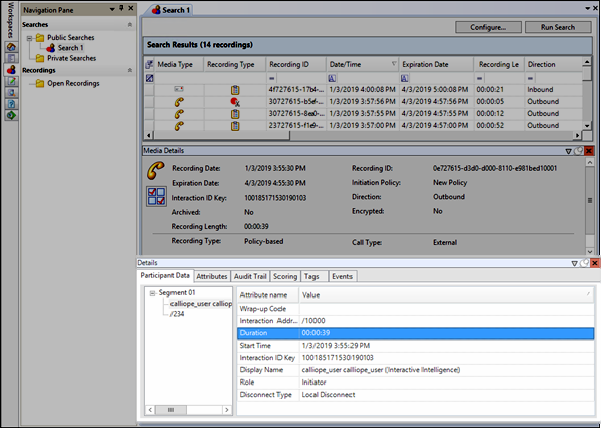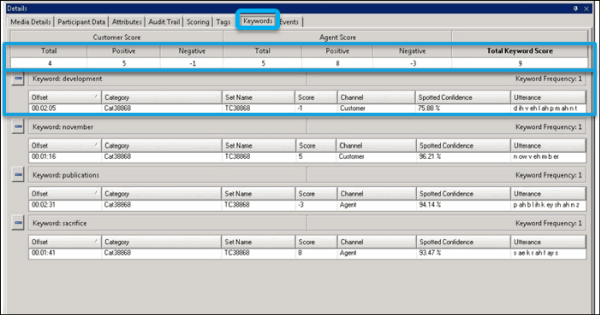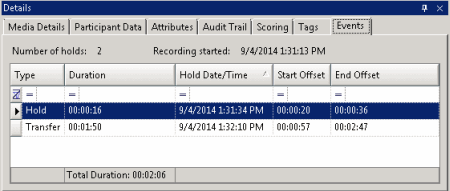- Contents
Interaction Recorder Client for IC Business Manager Help
Details Pane
The Details pane is displayed in the Search Results View in the Workspace.

When an interaction is selected, additional interaction details are displayed in the Details pane. The Details pane includes the following tabbed pages:
-
Participant Data
-
Attributes
-
Audit Trail
-
Scoring
-
Tags
-
Events

Note If Interaction Analyzer Keywords are associated with an interaction, a Keywords tabbed page is also displayed.

Participant Data page
The Participant Data page displays information on the parties of the selected interaction. The page displays Attributes and Values for the interaction participants.
Attributes page
The Attributes page displays the defined custom attributes that apply to this interaction.
The Attribute value field supports displaying multiple lines with the value text string. When modifying the Value, press Enter to add a new line to the attribute value string. To end the edit mode and save the changes, click the pencil icon in the row selector.

Note Adding or removing a Custom Attribute in Interaction Recorder client in IC Business Manager creates an audit entry for the recording. The audit trail entry for the change contains comments that describe the change.
You can only change the Value on the Attributes page; you cannot change the Attribute name on this page.
Audit Trail page
The Audit Trail page displays information on audit events. The information includes: Date/Time, Audit Event, User, and Comments on the event. Use the shortcut menu from the Audit Trail page to refresh the audit trail data.
Scoring page
The Scoring page is used to access a Questionnaire and Score a recording. Questionnaires that have previously been assigned to a recording are displayed on the Scoring page. Additional Questionnaires can be assigned to the recording on this page. Only questionnaires that have been published are available for scoring.
Notes
- Non-admin users only see Questionnaire
scorecards that they have scored. To allow users to see all scorecards
for a recording, the CIC administrator can create a Security
Policy so a user can view score
cards. This Security Policy can be applied to Agents or Roles.
Questionnaire Directory Admin Access and other security rights will still
apply. For non-admin users, in order to finish a scorecard that has already
been scored by another user, the user must first save the scorecard to
take ownership and then the user can finish the scorecard.
- The Scoring User column displays
the names of the users that scored the recording selected in the Search
Results grid. If the user, viewing the Search results, has the Can
Score Recordings Security Policy rights for the selected recording,
the Scoring User name is displayed in the Scoring User column. If the
user does not have the Can Score Recordings policy
rights, the Scoring User column is not displayed.
To assign a questionnaire, click Assign Questionnaire, and select a questionnaire from the Select Questionnaire dialog. When you click Assign Questionnaire the Select Questionnaire dialog is displayed. To assign a user to score the recording, select the Scoring user from the drop-down list. To select the completed scorecard for calibration purposes, select the Mark scorecard for calibration check box. To require an agent signature on the completed scorecard, select the Require scored agent signature check box. To assign a questionnaire to a recording you must have the Can Assign Questionnaires security right, assigned in Policy Editor.
To score a recording, on the Scoring page, select a Questionnaire and click Score. You can also right-click on a Questionnaire, and on the shortcut menu, click Score.
The Questionnaire to score the recording is displayed and the media player is launched displaying details of the recording. Playback forms vary according to the Media Type.
A Quality Scorecard Report can be generated from the Scoring page in the Details pane. To generate a report, on the Scoring page select a Questionnaire. Right-click, and on the shortcut menu, click Run Report.
Tags page
The Tags page displays Tags for a recording that were created in Policy Editor and assigned to a recording. Spotted Interaction Analyzer categories are also displayed on the Tags page. Tags can be added and edited in the Playback window Details pane on the Tags page. To open the Playback window, click Modify Tags. The Playback window is displayed. If the Details pane is not showing, in the Playback window right-click, and on the shortcut menu point to Show and click Details.
Note Adding or removing a Tag in Interaction Recorder client in IC Business Manager creates an audit entry for the recording. The audit trail entry for the change contains comments that describe the change.
Keywords page
Keywords and phrases spotted by Interaction Analyzer are stored along with recordings, allowing for rapid searching of recordings for playback. Policy Editor Initiation Policies determine which call interactions are analyzed for keywords and phrases.

If Interaction Analyzer Keywords are associated with an interaction, a Keywords page is available.
The Analyzer results information displayed on the Keywords page includes:
-
Customer Scores
-
Agent Scores
-
Total Keyword Score
-
Keyword name
-
Offset (time point in call of Keyword hit)
-
Category
-
Set Name
-
Keyword Score
-
Channel (Agent or Customer)
-
Spotted confidence
-
Utterance
Note: The Spotted Confidence value displayed is rounded to 2 decimal places. The tooltip for Spotted Confidence displays the value up to 4 decimal places.
For information on setting the score of a keyword or phrase, see the Interaction Analyzer Technical Reference in the PureConnect Documentation Library.
Events page
The Events page displays the Hold Event information. This tab is displayed for each recording if the user has sufficient security and access rights to be able to retrieve or playback the recording.


By default, the rows on the Events page are sorted in ascending order by the Start/Date/Time value. The columns displayed on the Events page are:
-
Type This value indicates the type of Hold event that occurred within the recording. Valid Hold display values are: Hold, Transfer, and Park.
-
Duration This value indicates the length of the Hold, rounded to the nearest second. The summary row for this column displays the total duration of the Holds (summed before any rounding) for this recording, and is rounded to the nearest second.
-
Hold Date/Time This value displays when the Hold began in local Date/Time. The summary row for this column displays the total number of Holds that occurred for this recording.
-
Start Offset This value displays when the Hold began as an offset from the beginning of the recording, rounded to the nearest second.
-
End Offset This value displays when the Hold ended as an offset from the beginning of the recording, rounded to the nearest second.
Note: If the duration for a Hold event is less than .5 seconds and greater than zero (0) seconds, the Event Duration states less than 1 second.
Moving the Details pane
You can undock the Details pane from the Workspace and move it to another location on your screen. To undock the Details pane, double-click the title bar. The Details pane moves from the Workspace. To move the Details pane to another place on your screen, click the title bar and drag the window.
To dock the Details pane back in the Workspace, double-click the title bar. The Details pane docks back in the Workspace.
Hiding the Details pane
There are two ways to Hide the Details pane, Hide and Auto Hide. When you Hide the Details pane, it does not appear in the Workspace. When you Auto Hide the Details pane, a tabbed page is displayed at the bottom of the Workspace. Auto Hide allows you to display a pop-up pane, leaving more Workspace for the Search Results View.
To Hide the Details pane, right-click the title bar, and on the shortcut menu, click Hide. To display the Details pane again, right-click in the Workspace and on the shortcut menu point to Show and click Details. The Details pane is displayed in the Workspace.
To Auto Hide the Details pane, right-click the title bar, and on the shortcut menu, click Auto Hide. A tabbed page is displayed at the bottom of the Workspace. To display the Details pane again, click the tab, and the Details pane pops up in the Workspace. To turn Auto Hide off, when the pane is displayed, right-click the title bar and click Auto Hide. The Details pane is displayed in the Workspace.
Related Topics
Working with Recording Search Results





